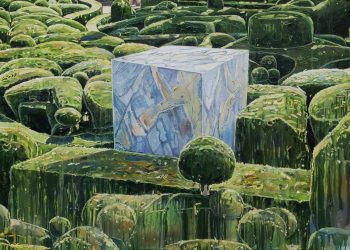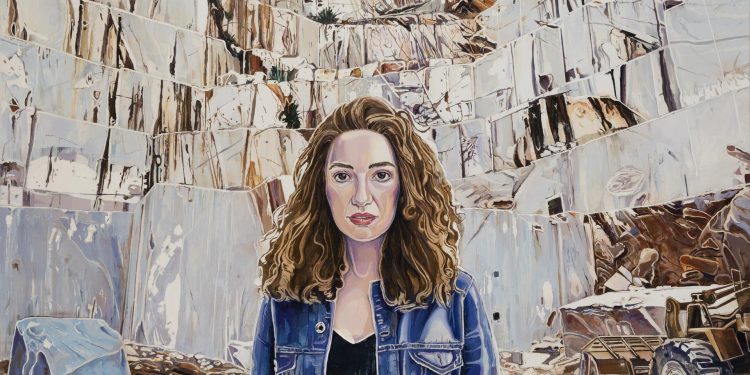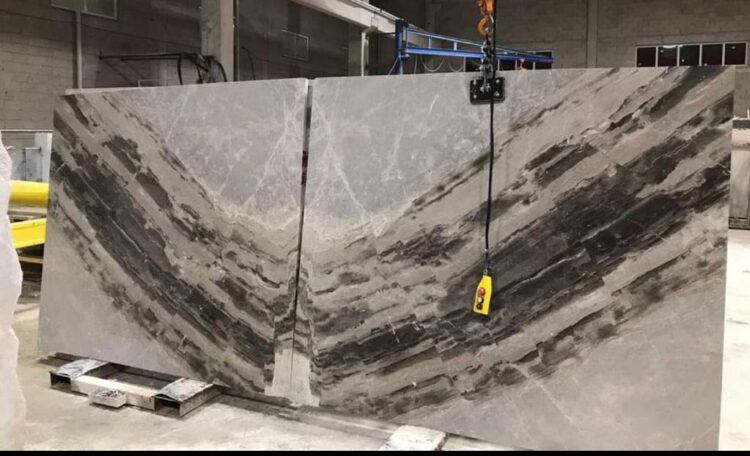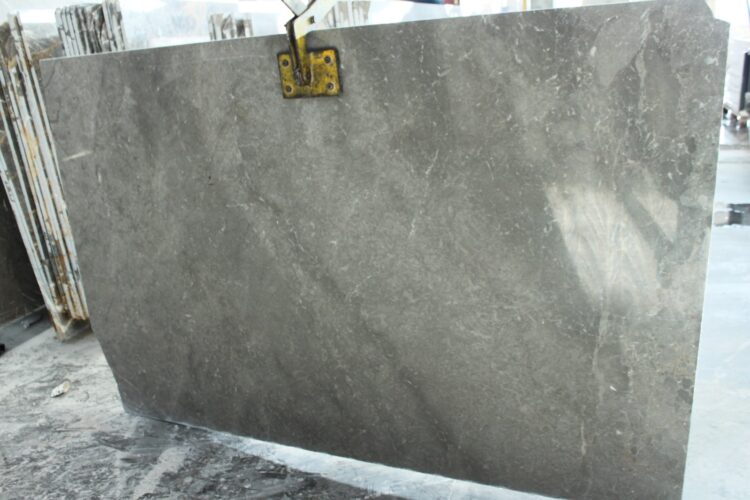She is a painter in love with nature… A young, outstanding artist of Turkish contemporary art … Burcu Perçin … Perçin, has been living with art since her very young age reflects what she sees on the canvas sometimes in blend with her dreams. The young artist, who also reflects her awareness for social and environmental issues, works on themes such as abandoned industrial spaces and the artificial nature scenes in the city center. Perçin’s natural stone quarries themed art works has started during her visit to Southeastern Turkey 7 years ago. She was amazed by the natural stone quarries there and started using this theme in her paintings. Thus, she has visited many quarries from Marmara Island to Yatağan and Afyonkarahisar, Karadeniz to Kemerburgaz and Carrara. Once she traveled 1200 km to reach a quarry with this passion. Let’s listen to her involvement with art, exhibitions she attended and her interest for natural stone quarries from her own words.
* How did you discover your passion for painting?
I have been dealing with art since I was very young. When I was a child I did ballet and studied music. In the middle school, I was interested in painting. During the time I was preparing for the examination of the High School of Fine Arts, I realized my passion and ability for painting and decided to be a painter. I owe my discipline to my high school years. Then, I was accepted to the Painting Department of Mimar Sinan University. When I was a student at Mimar Sinan, I was doing portraits and paintings of interior spaces. After I started working in my own atelier, I made paintings showing interior and outside scenes together.
In my first exhibition (2005), I pictured people and human made products in wild forests. My looking into the nature from the city put me to the center of the industry in the following period. Between 2007 and 2010, I made paintings of a series of outdoor spaces and empty highways. After 2010, I have painted the interiors of abandoned buildings and huge industrial plants. By the year 2014, I focused on stone and marble quarries and expressed the transformation in the nature. In the last 2 years, I have been working on an exhibition called ‘Filling the Green’, which focuses on artificial landscape.
How did the story of your natural stone quarries work started?
In my paintings, I work with my deep commitment to social and environmental issues. I usually center the affected environment. I am working on the themes such as abandoned industrial spaces, scavenged mountains, and artificial nature scenes in the city. The idea of the project I made about stone and marble quarries had occurred when first time I traveled in the Southeast 7 years ago. The stone quarries I saw there caused me think about the intervention to the mountains and to take photographs. My anxiety about the great change of the mountains, which is a great value both in historical, mythological, cultural, ecological and economical terms, turned into a series in time and I opened the exhibition ‘Mountains Have No Owners’ in 2014.
* Which marble quarries did you visit in Turkey and abroad to reveal these artifacts?
In Turkey; Marmara Island, Yatağan, Afyon, the Black Sea Region and Kemerburgaz are the places I visited in order to create this series. It was not difficult for me to reach these quarries spread over almost every region in Turkey. I once made 1,200 kms at one drive. Being in the field and making observations is feeding me and helping me create both the visual impact and the content in my work. I usually travel a few days at different times. After I opened the exhibition, my interest in this theme continued and I went to Carrara where the biggest marble quarries of the world are located. I went out of there and continued to do my paintings. Most of the quarries are formally dissimilar, but generally in white tones. Observing thousand tones of white marble has shaped how to use this tonal richness in my paintings. In addition, when I was traveling in quarries, I was able to see the materials closely and touch them. This made me create sculptural forms in my work. I made marble relieves by cutting off natural stones and marbles by taking inspiration from my painting style.
* Do they help you when you go to the quarries? Have you ever had a hard time?
This is something I am generally lucky in. For example, I went to Marmara Island with a friend of mine, thanks to someone he recognized, we were allowed to take photographs. In Carrara coincidentally, I met with a geologist, who is working there and thanks to good-hearted Carlo, I could safely enter into many quarries. In some places when I tell I am a painter and show them my catalog, they respond with sympathy and make it easier for me to shoot. There were also some images I have shot without permission … For example the marble quarry in Yatağan! I was on a long trip early in the summer with my family in 2013. When I came to Yatağan, I saw a mountain that was white and mined, from a distance. We reached this mountain by asking around. While my dad and mom were waiting in the car, I went into the quarry alone to take pictures. The sunrays created a magical atmosphere in the large marble quarry! In silence, the only sound was coming from a few work machines. There was an amazing aesthetic scene created by light. I roamed around with the pleasure of finding the material I was looking for. Everything was so small in the huge mountain. The top of my head was covered with marble dust as I was walking. I was little scared not to see anyone around. When I was about to return, I noticed a man who seemed like a point from the far distance. He was probably one of the workers. I felt he saw me too. I also painted that person in one of my paintings in the show.

* When you visit marble quarries, I wonder how you feel when you look at the quarries. What kind of messages the quarries give to you and what kind of a message do you want to give via your marble quarry themed paintings?
First of all, I am witnessing that the mountains are removed from being a living space and source for all living things and consumed in the service of the global capital. I see that geography has changed because of human interventions, and as a painter, I need to convey my impressions of this destruction of nature. In the production process, after the irreversible interventions made in nature, nature’s answer to this question was often one of the questions that came to mind. In addition, these images link me picturesquely to this topic. The resulting form, color and texture have a quality that answers my technical survey. When I stand alone with these places, the aesthetic power of the objects and the surfaces, seizes me, so the aesthetic perception that is formed can sometimes come before the feeling of destruction. For example, when I walk on a marble quarry, even on the surface of a marble that I have closely examined, I capture different stories for my art , which helps me to reflect new interpretations on the canvas.
* Do you see yourself in an environmental movement?
I am not in an environmental movement or formation. I usually focus on environmental issues in my work. I do not give advice in a didactic way, I want to lead people to curiosity, and maybe cause them to think a bit more about these basic issues. Nevertheless, I feel the desire to meet with people from different disciplines or with artists to perform exhibitions on environment-oriented projects.

* Where is your atelier, can you talk a little about your production process? What kind of technique do you use in your paintings?
My atelier is in Moda. I work regularly and pay attention to discipline. I usually go to my atelier at 11 am and work with music and coffee for 7-8 hours. My methods, palette, composition and understanding, change, along with the subject. I prefer to use a self-specific, experimental technique. The perception of my technique may vary depending on the distance you look at it. The abstract forms you see from a close distance can be perceived within a photographic sharpness as a part of the whole from a far distance. Therefore, I can say that my painting refers to both the realistic and the abstract painting at the same time. I express myself through the disciplines of sculpture and photography as well. The photo-collages, oil paintings on photos and natural stone relieve show parallelism to my paintings.
* How do you determine the stones you will use in your works with natural stone? Which stones do you mainly use and where do you supply them?
I determine the stones based on the sketch I make. I determine the stones and the colours I will use as I do the sketches. I am collecting these stones by visiting many marble producers in and around Istanbul. I try to evaluate the waste stones I find in these regions as much as possible. Most are marble, and other natural stones such as granite and travertine can be involved. I do not always need to intervene with colour as the natural colors of the stones are so beautiful and striking.
* Is there a marble quarry you want to paint?
Now that I am working on a different theme, I do not think of a specific place, but I would like to see a big diamond mine and work on it.
* Have you ever received an invitation from the marble fairs to exhibit your works? Would you accept if such an invitation comes?
I received the invitation but I did not accept it because of inconvenient circumstances. I was thrilled to exhibit my marble arts at art fairs and they attracted great attention. However, due to the cost and weight of these items, they were limited in numbers on the exhibition stands. For this reason, I would like to create bigger projects with my marble art and apply them on a specific space with a sponsor’s support.
Interview : Şehriban ÇİMEN

























 +90 532 585 51 95
+90 532 585 51 95 +90 532 585 51 95
+90 532 585 51 95